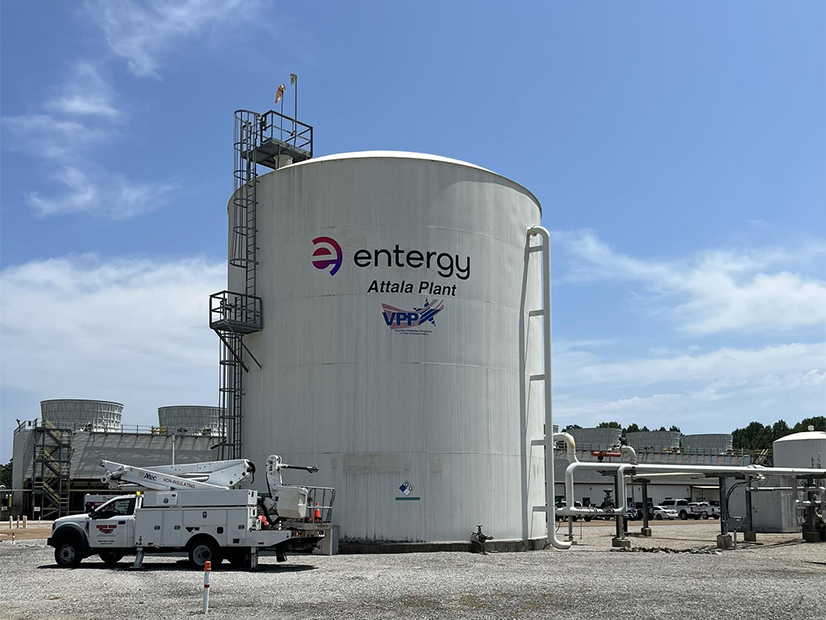Stakeholders appear divided over MISO’s proposal to use a downward sloping demand curve in its capacity auction, with criticism aimed mostly at a provision to allow utilities to opt out of the auction for three years at a time.
MISO at the end of September filed for FERC permission to replace its vertical demand curve used in its capacity auction with a sloped demand curve that assigns value to excess capacity (ER23-2977). (See MISO South Support for Sloped Demand Curve Wanes on Opt-out Provision.) Stakeholders’ comments on MISO’s filing rolled in last week.
Consumers Energy filed in support of the sloped demand curve and said it should take care of the auction clearing capacity prices at either very close to $0/MW-day or near the cost of new entry, and drive “proper” grid investments.
The Michigan-based utility said MISO’s “current model struggles to provide adequate price signals and investment incentives and fails to promote efficient resource planning or accurately reflect the reliability value of incremental capacity.”
The Kentucky Public Service Commission also supported the sloping demand curve, saying it would allow excess capacity “to be assigned value commensurate with its reliability contribution along the downward slope of the curve.”
The Electric Power Supply Association called the new curve “a key element in the ISO’s efforts to address the region’s resource adequacy challenges and support reliable operations.” Calpine also chimed in, saying the curve will yield more accurate capacity prices.
However, the Sierra Club, Natural Resources Defense Council and the Sustainable FERC Project said while they agreed with most aspects of MISO’s plan to implement the sloped demand curve, they took issue with MISO’s plan to impose an “X% adder” on load-serving entities that opt out of the auction altogether. The adder will require those LSEs to secure more capacity than strictly necessary to meet MISO’s one-day-in-10-years system reliability standard. The adder will be based on how much excess capacity is procured through the auction using the sloped demand curve in previous years.
The trio said the adder introduces “an artificial financial disincentive against LSEs utilizing the opt-out mechanism, undermining the suite of choices available to LSEs, and it will impose significant artificial costs on ratepayers.”
In a joint protest, the Public Utility Commission of Texas and the Arkansas Public Service Commission likewise said MISO’s opt-out provision will penalize LSEs. Entergy and Cleco joined in criticism of the opt-out provision and advocated for allowing LSEs to partially opt out of the capacity auction with a portion of their load.
The Louisiana Public Service Commission said MISO’s requirement that LSEs procure beyond the 1-in-10 standard if they wish to opt out of the auction “all but guarantees” LSEs will choose to participate in MISO’s auctions. The commission said the demand curve won’t incent new capacity, just “shift dollars around among existing capacity, while requiring LSEs” to acquire more capacity than necessary to meet loss-of-load expectation standards.
Other stakeholders struck a harsher tone against the whole of MISO’s proposal.
The Mississippi Public Service Commission said MISO’s narrative that a downward sloping demand curve is necessary for reliability is untrue. It said the price signal that the sloped demand curve is designed to evoke is unnecessary because most MISO utilities are vertically integrated and can roll the costs of generation needed to meet resource adequacy targets into their rate bases.
“The premise — that ‘incremental capacity’ above that needed to satisfy the one day in 10 years loss-of-load expectation standard — is pure ex cathedra hokum,” the commission told FERC. “Energy from installed capacity, not capacity that clears an auction, is what serves load and provides reliability. Efforts in MISO that establish appropriate energy pricing, including scarcity pricing, market monitoring that prevents physical and economic withholding, and the desire to profit from existing generation investment will motivate generators to produce electricity, irrespective of whether those generators cleared in the Planning Reserve Auction.”
American Municipal Power, Missouri Joint Municipal Electric Utility Commission, Southern Minnesota Municipal Power Agency and WPPI Energy asked FERC to completely reject MISO’s proposal, saying they doubted the changes are necessary.
“MISO has not justified that these dramatic changes to its resource adequacy construct are warranted. Nor has MISO acknowledged or justified largely eliminating critical auction clearing price mitigation that protects against excessive prices, or explained how its various revisions can be implemented in a coherent, just and reasonable manner,” the utilities said.
They said they didn’t see how FERC could allow MISO to clear its auction beyond the current limit of 1.75 times the cost of new entry for generation. They also said MISO’s opt-out provision is murky and its proposed opt-out deficiency charge for LSEs that fail to come up with the adder amount of capacity is “unduly punitive.”


